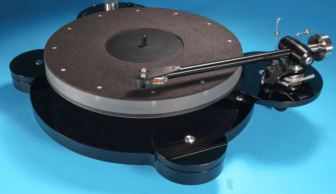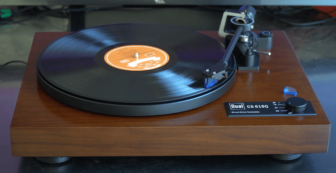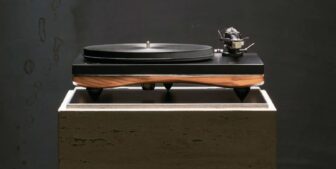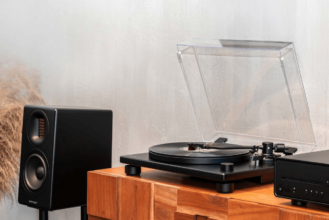Audio Technica AT-LP30W Review: Go Vinyl
An easy way to go vinyl is with Audio Technica’s AT-LP30W, Noel Keywood thinks. Read our Audio Technica AT-LP30W Review.
It’s always nice to review an Audio Technica (Japan) turntable or cartridge since they’re intelligently engineered and easy to set up and use. And that was the case with the budget AT-LPW30 belt drive turntable I’m reviewing here. For that princely sum – or pauper’s sum – you get a complete package with cartridge and phono stage. It can’t be bad.
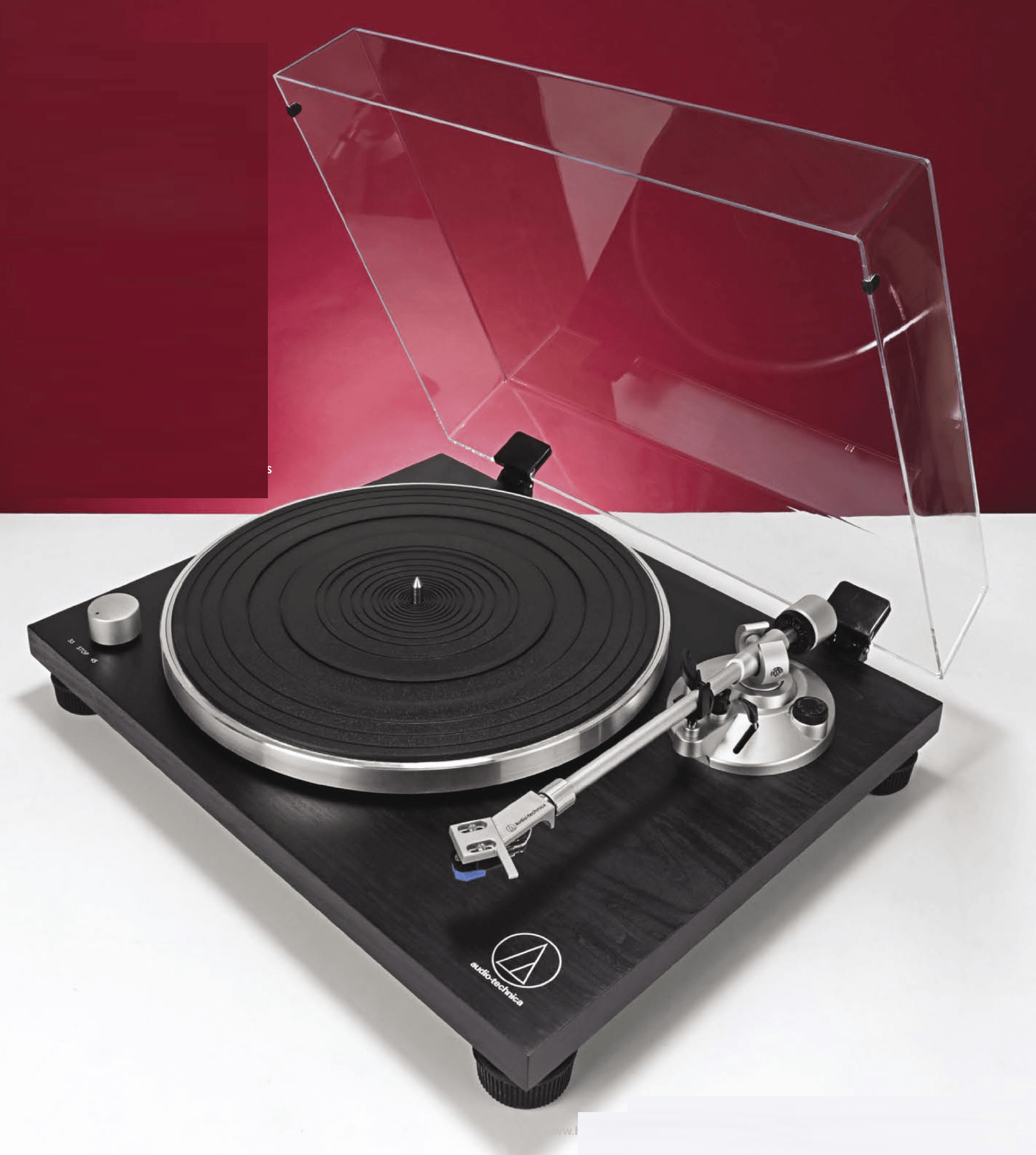
I was bemused to find two platter mats amongst the usual array of bits that come with any such turntable: one of ribbed rubber, the other a flat felt slip-mat. Which sounds best? Generally ribbed rubber gives a slightly deader sound and the ribs better support an LPs surface, especially when dished, but some prefer felt.
The mats – one or other – sit on a light, die-cast aluminum platter, helping damp it down. Driving the platter is a d.c. servo motor with two speeds: 33rpm or 45rpm. Speed change is electronic, so no need to manually move the belt between different pulley diameters, just turn a knob at front of the plinth.
Audio Technica doesn’t spring any surprises at this price, and they keep set-up as simple as possible, following a tried and tested pattern. Because antiskate bias is built into the arm, adjustable by a small knob, there’s no bias weight to fiddle with. The alloy platter is dropped onto the tapered motor shaft, and by a bit of deft finger work, the rubber belt slipped over the motor pulley.
A separate bayonet fixing headshell fitted with an AT-VM95C moving magnet (MM) cartridge must be plugged in, the arm balanced, and tracking force set to 2gms using a scale on the counterweight, so no stylus force gauge needed.
There is a swankier AT-LPW40 variant (£) with walnut veneer, black carbon-fibre tone arm and AT-95E cartridge. That’s E for elliptical stylus profile, whilst the more basic AT-95C has a conical stylus – as simple as it gets. No great disaster, though: you get a vaguer treble from a conical – less insight at high frequencies.
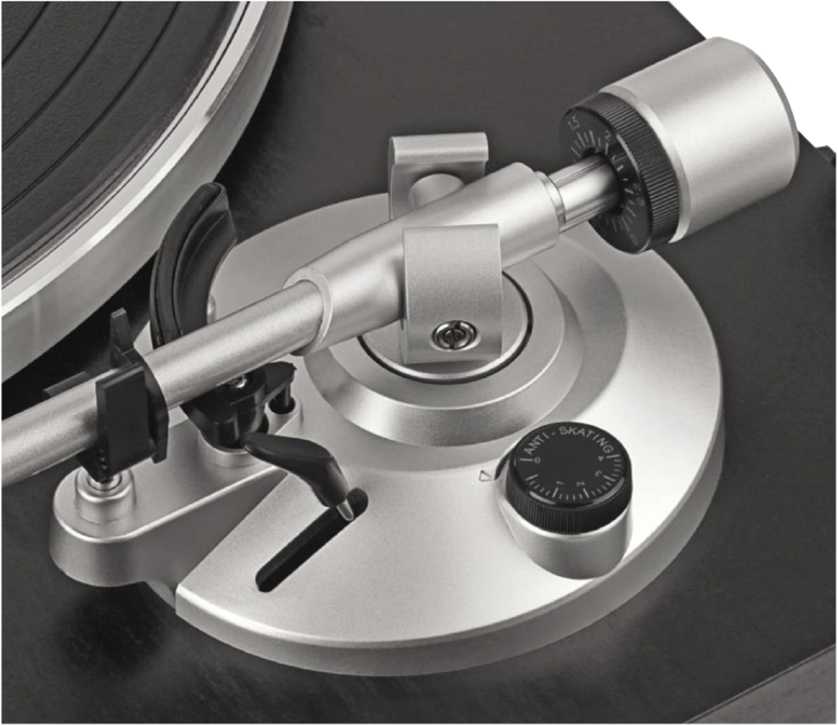
Anti-skate (outward bias) is conveniently applied by a dial on the arm base, shown here. Easier than the simple thread and weight system that’s still common. The horizontal bearings are adjustable ball races.
As I fiddled with the bits to put them together, my fingers told me this was not a Japanese turntable, as the arm, in particular, was a trifle loose on its vertical bearing and the counterweight dial a slack fit. Peering underneath led me to a Serial Number in Chinese characters, plus a Made in China legend – an OEM product then.
My underside inspection also revealed two interesting little holes in a plastic cover, one marked 33 and the other 45, with +/- signs. Aha! Speed adjustment. The User Manual says nothing about this as traditionally it demands test equipment few will have at home, but nowadays a mobile ‘phone with RPM app can do the job so those who are pitch sensitive – usually musicians – can tweak the LP30W to set it right – see our boxout.As delivered, the platter ran +0.5% fast, which was a small error.
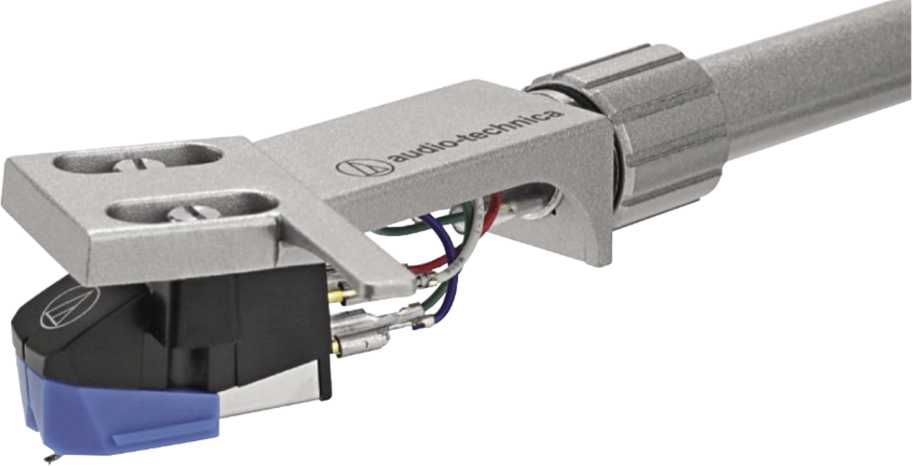
Audio Technica’s bayonet fixing removable headshell comes fitted with their own AT-95C budget MM cartridge with basic Conical stylus assembly, colour-coded blue. It can be upgraded easily and cheaply to better stylus profiles.
The arm is satisfactory rather than lovely. It has a lightweight feel and the arm rest and safety clip are insubstantial, but the vital clip that prevents accidents worked well. The manual lift/lower lever felt basic. There are no auto systems of any sort, so no auto-stop at the end of an LP side. However, when balanced out the arm floated freely, laterally and vertically, and the headshell has a decent finger lift for hand cueing. At the price, it’s a decent offering.
The removable headshell makes cartridge changing easy, and measurement shows removables don’t affect arm behavior. In practice, they can be upgraded at a low cost for better results, so I favor them in this price range.
The phono stage is MM only and can be switched in/out via a rear slide switch. With it switched in the turntable gives a Line output suitable for any amplifier, with it switched out the cartridge signal can be sent direct to an external phono stage of higher ability, even one able to handle moving coil cartridges for those with such ambitions.
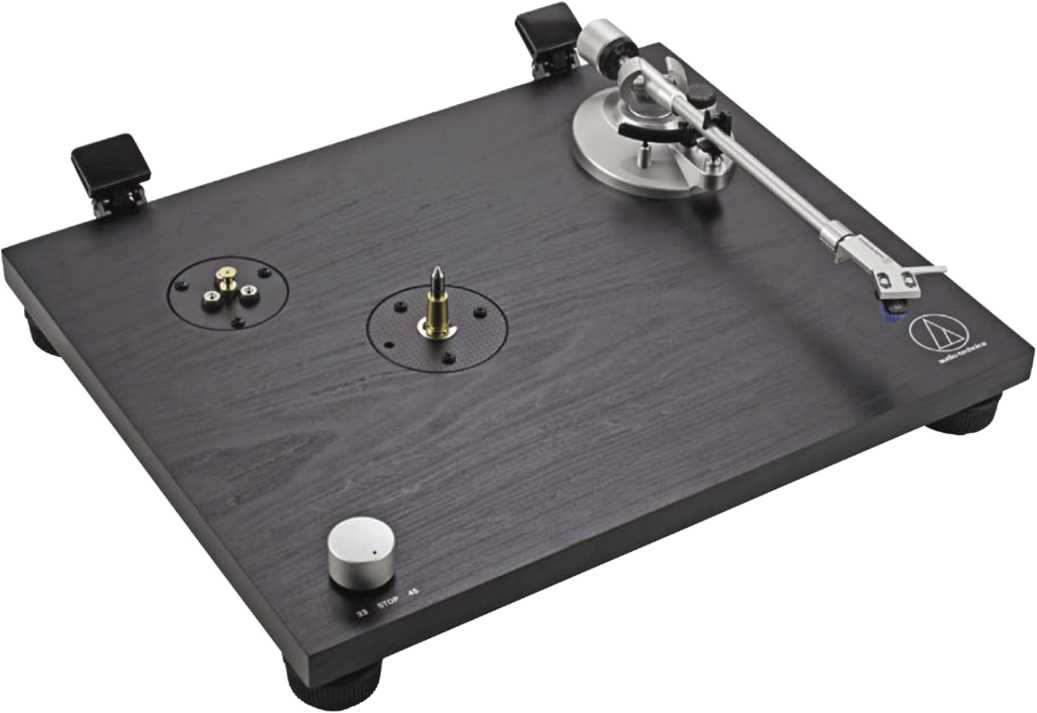
A flat MDF veneered plinth on four non-adjustable feet, supporting motor and main bearing. It needs a flat and stable platform free from vibration.
Where the cheaper (£) Lenco LBT-188 I reviewed last month had a lovely deep gloss walnut veneered plinth, the AT was more prosaic, its black veneer visually unengaging. Functional rather than pretty. But build quality was good all-round.
Power comes from an external wall wart, delivering 12V/0.5A. This means there is no main earth and no chance of an earth loop causing hum, rendering the LPW30 hum-free.
SOUND QUALITY
I used the Audio Technica with our Creek Voyage i20 amplifier that comes with an excellent internal phono stage, as well as Line input so as to hear the internal stage, but I did not spend too long here as these things are peas out of a pod, manufactured somewhere in China, their gain always a low x60 (36dB). This just means you have to turn the volume up a little. Cheap and cheerful they may be but accurately equalised so no great sonic disaster.

At rear a single pair of phono socket outputs switchable from Line to Phono. The Line output utilises an internal phono stage, the Phono output is direct from the cartridge, to feed an external preamplifier. Also here is a push-button power switch for the 12V power input.
Loudspeakers used were our Martin Logan ESL-X hybrid electrostatics connected by Chord Company Signature Reference screened cables.
“I also became aware of the turntable’s fine speed control, the band coming over as fast and almost clinically well timed”
Immediate impression when set to Phono and connected to the Creek’s phono stage – a soft sound. But one in keeping with vinyl expectations: no hard spits or pops, no graunchy digital-style treble. Easy going, laconic. Bass guitar in Dire Straits Ride Across The River underpinned the track firmly and there was plenty of body in the sound as you hope and expect from LP, Mark Knopfler’s vocals clear at centre stage. In keeping with a decent arm the stage was wide, open and had a fine sense of depth, making for an atmospheric delivery.
Further up the frequency band treble was vague, as expected from a simple conical stylus.This affected strummed guitar from Neil Young’s Tell Me Why where the strings lacked bite and there was general vagueness. I also got to hear some midband hardness of tone.
Where a.c. synchronous motors of the past were speed locked to mains frequency, today’s d.c. servo-motors from China can be speed adjusted. Should turntable speed and musical pitch bother you this is something to bear in mind. They have better speed stability than a.c. motors and speed adjustment is possible too, as in the AT-LPW30.
Audio Technica say nothing about such adjustment in their User Manual. Likely because – traditionally – to adjust speed a test LP is needed, plus a way of reading frequency of the 3150Hz test tone it produces. This is not an easy adjustment to make at home. Or it wasn’t until recently.
Times have changed and you can now measure turntable speed with your iPhone! No need for electronic test equipment, just buy an RPM app. for $ (free trial available), place ‘phone on platter and get a near-instant readout. Cheap and simple, yet also very accurate; it uses the iPhone’s in-built accelerometers.
I did this with the LPW30 and RPM told me it was running +0.62% fast, within a whisker of the +0.5% figure shown by our Wow&Flutter meter reading an accurate and stable DIN 45 545 test disc. You must calibrate RPM first (it self-calibrates) and use longest average for such accuracy.
Was the LPW30 easy to adjust? Not really. There is a small adjuster (board mounted mini-potentiometer) buried deep in a dark hole, turned by a small flat bladed jewellers’ screwdriver. I’ve dealt with these two-bob jobs many times before and know ’em well. I felt the blade sink home easily but the calibration is very coarse, a small twist giving big speed change. I got to +0.15% after nudging the adjuster and felt that was good enough, so speed adjustment to good accuracy is definitely doable, taking 15-20minutes or so.
The RPM app’s readout of speed as +0.63% fast, an acceptable error. Adjustment reduced this.
The wow/flutter figure of 0.20% looks high, but it is a basic unweighted value.
Spinning Big Band Spectacular from the Syd Lawrence Orchestra made clear the clarity and punch of this modern recording wasn’t obvious.
At this point I spotted an Audio Technica headshell with Ortofon 2M Black cartridge mounted in it and made a quick change! This brought the sound stage into focus and provided punch to drums in the intro to Sing Sing Sing (Syd Lawrence Orchestra), making for a very high quality vinyl sound. It was here that I also became aware of the turntable’s fine speed control, the band coming over as fast and almost clinically well timed (which they are as a band of skilled musicians used to playing live).
OK, 2M Black is a £ MM cartridge but it demonstrated that the LP30W is capable of providing such a sound. And Audio Technica offer a cheaper upgrade path through a wide range of styli for the AT95, up to Microlinear (£ 130) and Shibata (£ 190) tip profiles, for more refined and concise treble.
The internal phono stage had a slightly sharper sound and lighter bass than that of the Creek but this wasn’t out of place with the AT95C, less suiting the 2M Black. Volume had to be cranked up substantially as well. Still a good enough stage though with no great weaknesses, certainly none to compromise LP’s basic qualities. I thoroughly enjoyed using this turntable: it made vinyl fun and a great listen.
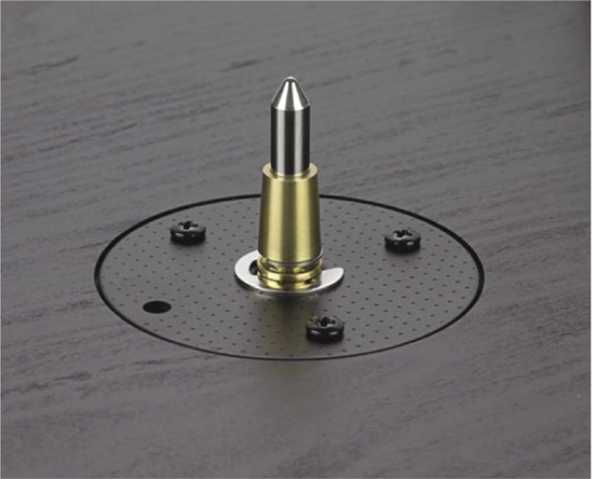
The main bearing has a brass taper to mate with and hold the platter. Tightly machined with no slack, this is a high quality item common to Chinese manufactured turntables, contributing to speed stability.
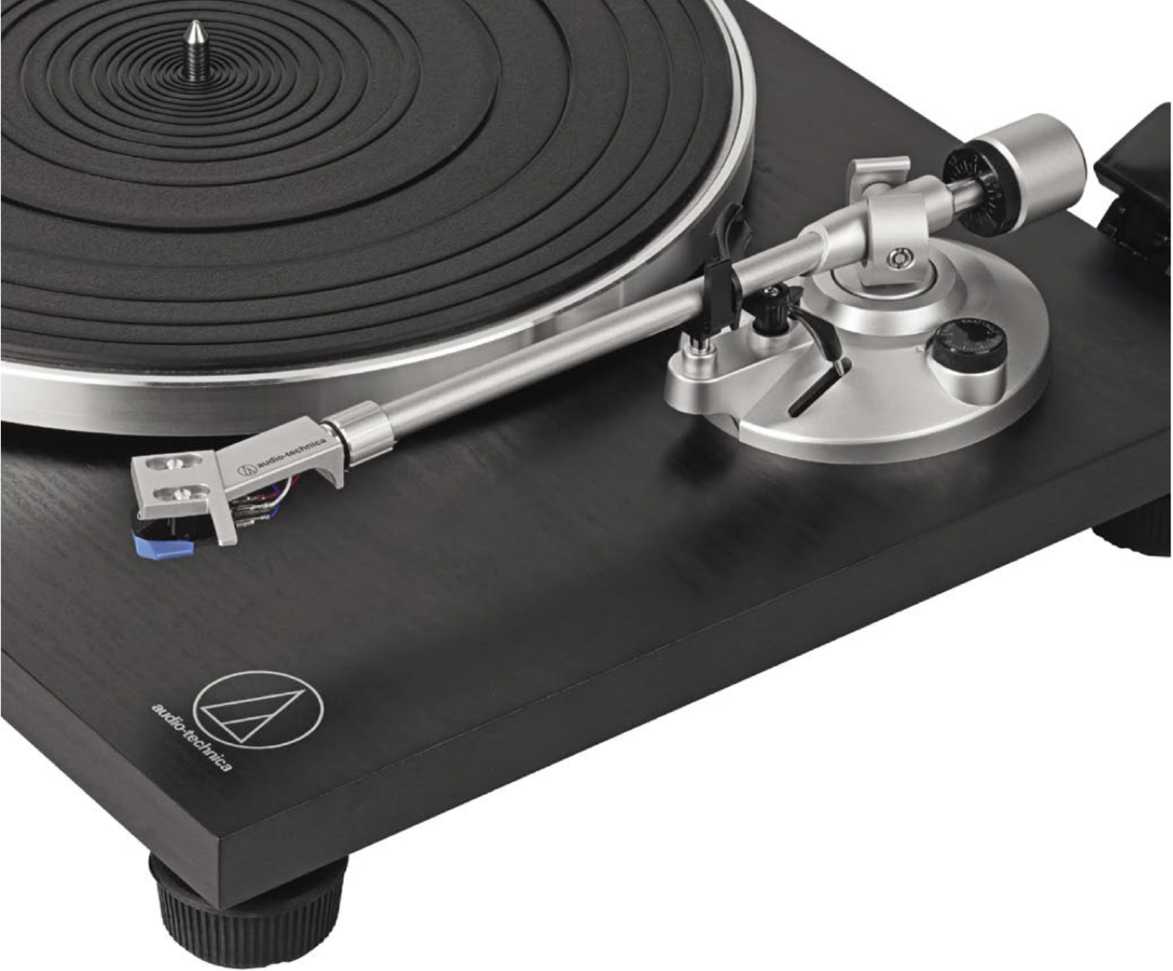
A neatly finished tonearm with removable headshell that has a usable finger lift. Further back lies an effective arm clip on the rest to prevent accidents, and beside it a cue lever actuating a damped lowering platform.
+(0)113 277 1441
www.eu.audio-technica.com
MEASURED PERFORMANCE
The 3150Hz test tone of a DIN 45-452 test disc varied from 3164-3168Hz on our Wow&Flutter meter. This is a very small amount of speed change (wander), resulting in a low DIN weighted Wow & Flutter value of 0.08% (0.05% to Japanese JIS standard). Speed error was +0.5%; around 1% is considered audible as a change of pitch so this is acceptable and speed can be adjusted.
The arm has a substantial bending mode at 350Hz our analysis of vibration with a Bruel&Kjaer accelerometer on the head shell shows. This is a relatively high frequency, due to light weight cartridge/ headshell assembly, and light stiff tube. There was some high frequency disturbance too. With a narrow peak however, it doesn’t encompass a lot of energy and is a decent result for a budget arm.
Phono stage equalisation was accurate and there is a small degree of warp filtering (-5dB at 5Hz) to lessen loudspeaker cone flap. Gain was low as always from China-sourced turntables, measuring x60 (36dB) where x100 (40dB) is a standard.
The AT-95C cartridge tracked reasonably well, just clearing a 60 muym lateral cut at 300Hz on our CBS STR-112 test disc. The maximum 45 muym vertical cut was cleared too, albeit with obvious second harmonic distortion from VTA error. Frequency response (JVC TRS-1007) rolled down slowly toward high frequencies, measuring -2dB at 10kHz – enough to give an obviously soft, even slightly warm sound, somewhat in vinyl tradition, if less accurate than is possible nowadays.
A good if not perfect set of results, speed being a tad fast, and the arm lively. NK
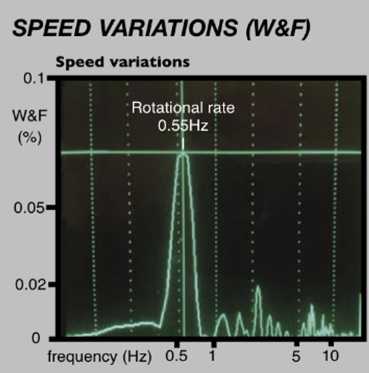
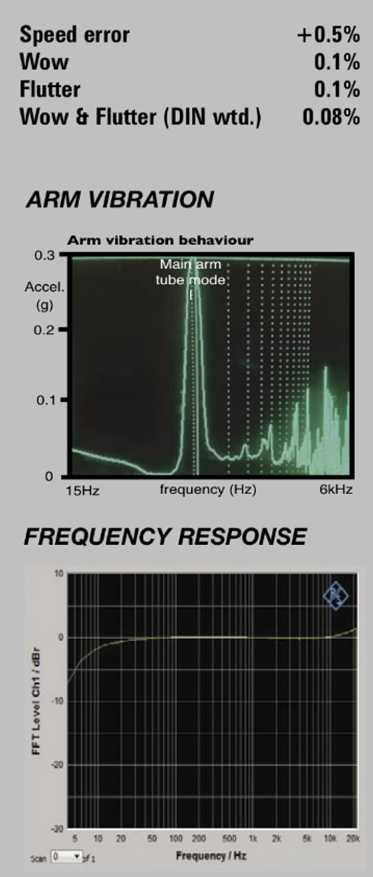
CONCLUSION
The AT-LP30W is a well judged product all-round: easy to set up, easy to use, upgradable and – importantly! – of good sound quality as delivered.You do get to hear the limitations of a budget cartridge but this is inevitable. There is a clear upgrade path through the fitment of better styli to the AT95 body and they won’t break the bank.
Easily a top budget turntable then, right up amongst the best, or even the best at this price point. Wholeheartedly recommended.
VERDICT
When you purchase through links on our site, I may earn an affiliate commission. Here’s how it works.







